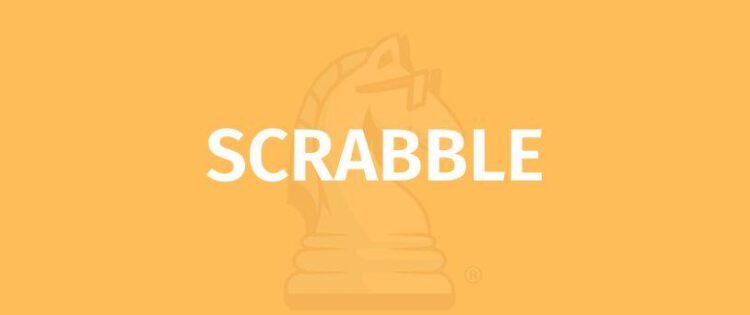
OBJECTIVE OF SCRABBLE: Earn more points than other players by forming interlocking words on the game board in a crossword puzzle fashion.
NUMBER OF PLAYERS: 2 to 4 players
MATERIALS OF SCRABBLE: Scrabble game board, 100 letter tiles, letter bag, four letter racks
TYPE OF GAME: Board Game
AUDIENCE: All ages
OVERVIEW OF SCRABBLE
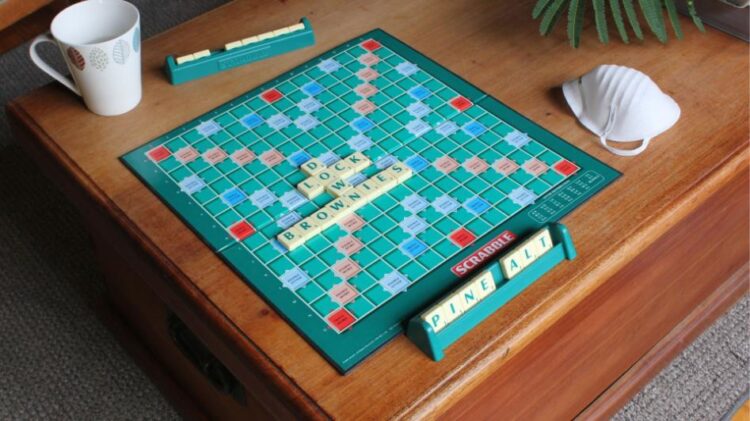
Scrabble is a classic board game that you can play in pretty much any setting: in the classroom, after dinner at home, or at a friend’s house. A board-and-tile game for 2 to 4 players, Scrabble is a word game that plays similarly to crossword puzzles. So, if you’re a word-game lover, this game will surely be up your alley!
It’s pretty incredible how popular Scrabble is! This game is sold in 121 countries in more than 30 languages! And, in total, more than 150 million Scrabble sets have been sold, with more than a third of American homes and half of British homes owning a Scrabble set!
Still not convinced about its sheer popularity? There’s a World Scrabble Championship held every year since 2013 and, before then, every odd year since 1991!
Other similar games word game lovers would enjoy include Quiddler, Codenames, and even Wordle!
HISTORY OF SCRABBLE
After analyzing games, Alfred Mosher Butts wanted to make a fun word game that employed both skill and chance by combining anagrams and crossword puzzles. Butts studied and calculated letter frequency in The New York Times. From this data, Butts gave each letter a point value, which you can see on the Scrabble letter tiles in the game today. Pretty cool, right?
Initially, he named the game Lexico, then Criss Cross Words, before finally trademarking the game as the famous “Scrabble” in 1948. Have you ever wondered what Scrabble means? According to the dictionary, it means, “to scratch or grope around to find, collect, or hold on to something.” We think that’s a pretty fitting name!
So, now that we’ve got all that heavy background stuff out of the way, it’s time to get to learn the Scrabble rules inside out! Let’s get into it!
SET UP FOR SCRABBLE
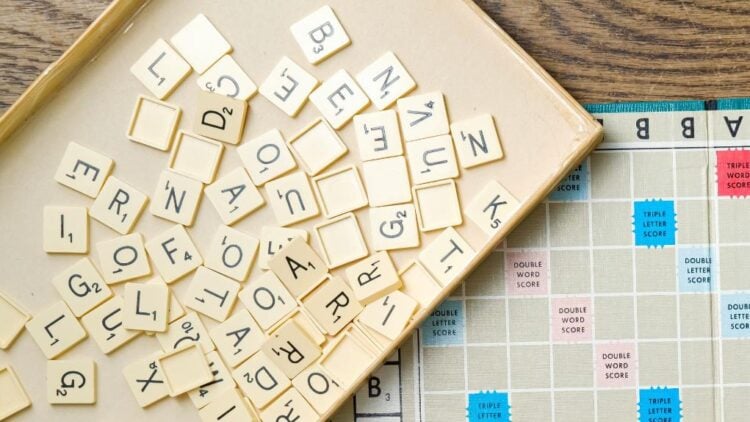
Of course, before you get started, you’ll need to understand the Scrabble game’s contents and set up the game first.
WHAT’S IN THE BOX?
A Scrabble set is made up of a Scrabble board, letter tiles, and a tile pouch.
THE SCRABBLE BOARD
The Scrabble board is a large square grid: 15 squares tall and 15 squares wide. While most squares on the Scrabble board are basic and don’t come with any extra power, there are colored premium squares strategically dotted across the board. These are: Double Letter, Triple Letter, Double Word, and Triple Word.
As you play the game, the letter tiles fit in the squares on the board.
LETTER TILES
Scrabble comes with 100 letter tiles to be used in gameplay. 98 of these have both a letter and a point value. Letter tiles each have different point values. The values are dependent upon how common or rare the letter is and the level of difficulty in playing the letter.
There are also 2 blank tiles that you can use as wild tiles. These tiles can substitute any letter. A blank tile in gameplay remains as the substituted letter for the entirety of the game. While a blank tile may be a good tile to have in your tile rack, note that blank tiles, unfortunately, do not have any point value.
TILE VALUES
- 0 points: Blank Tiles
- 1 point: A, E, I, L, N, O, R, S, T, U
- 2 points: D, G
- 3 points: B, C, M, P
- 4 points: F, H, V, W, Y
- 5 points: K
- 8 points: J, X
- 10 points: Q, Z
TILE POUCH
Besides the all-too-important Scrabble board and letter tiles, you can also find a tile pouch in the Scrabble set. This pouch holds all the letter tiles, making it easier to transport the tiles and discouraging players from picking and choosing tiles by peeking at the tiles beforehand.
BEFORE YOU BEGIN PLAY
All letter tiles go in the pouch. Then, mix them all up by giving the pouch a good shake. Then, each player draws just one letter tile from the pouch to determine who plays first. The player who draws a letter closest to “A” goes first. The blank tile beats all other tiles, including the “A.”
Once you have determined which player will go first, put all the tiles back into the pouch and give it a good shake to mix up the tiles once again. Put the letters back into the pouch and mix again.
Finally, starting with the player who will play first, each player draws seven tiles from the pouch and puts them on their tile rack. Keep in mind that players must maintain seven tiles throughout the game until the end of the game!
A final note: It’s also worth agreeing on a dictionary to use while playing. Looking up words in the dictionary during play is forbidden, but you can look up any disputed words once a player plays the word. Here is a Scrabble Dictionary directly from Hasbro!
HOW TO PLAY SCRABBLE: SCRABBLE RULES
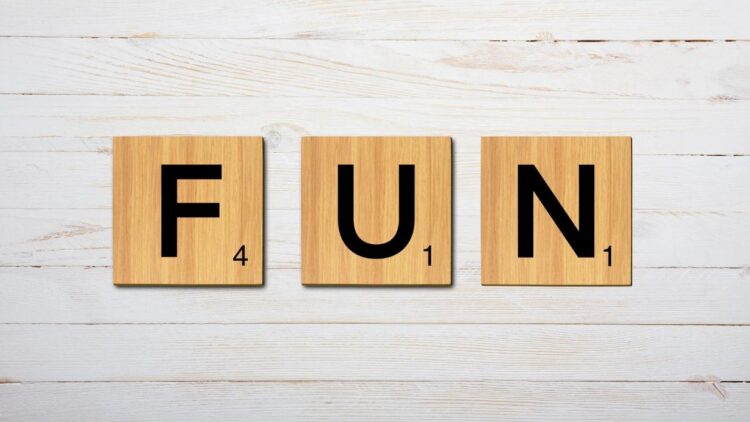
And now that you’ve properly set up the game of Scrabble, the fun begins! Here are the official rules for Scrabble.
PLAYING THE FIRST WORD
The first player must use 2 or more of their letter tiles on their rack to play the first word. The first player must place their word either vertically or horizontally on the star square in the center of the game board.
The star the first player plays on is a premium square and doubles the score of the player. So, if the player’s tile value of the word is 10 points, they win 20 points total.
You must keep track of the points throughout the game. Scoring can get a bit complicated, but don’t worry, we’ll go over scoring in Scrabble much more in detail below!
DRAWING NEW TILES
To end a player’s turn, they must draw new letter tiles from the pouch to replace the ones they have used this turn. A player must always have 7 tiles on their rack unless there are simply no more tiles in the pouch, which will happen near the end of the game.
After the first player places their word, calculates their score, and draws new tiles, play moves to the left.
BUILDING OFF AN EXISTING WORD
After the first player plays the first word, every other word played will be built off the first word and any other words that extend from it. In other words, you cannot simply create another word on the board. For a word to be valid, the letter tiles must be connected somehow. Before we dive deeper into this section, let us reiterate: you can only place words horizontally (from left to right) or vertically (from top to bottom).
Here are three ways to build off an existing word:
- Add one or more letters to words already on the board. For example, if “DRAG” is on the board, you could add the letter “S” to create the word “DRAGS,” or if you have the letters “O” and “N,” you could create the word “DRAGON.” Even further, if you have “O,” “N,” and “S,” you could add those 3 tiles to the existing word to create DRAGONS.
- Put a new word at a right angle to an existing word on the board by using at least one letter already on the board or adding to it. For example, if the word “NOISE” is on the board, you can use the “E” on the board to create a new word like “CRANE.” In this example, if NOISE is horizontal on the board, CRANE would be vertical.
- Put a new word parallel to an existing word. For example, if the word “DONE” is on the board, you could put the word “IBIS” parallel to the letters “N” and “E” on DONE. In this way, you create three separate words in one turn: IBIS, IN, and BE.
It’s very important to pay attention to all connected tiles! Everything must make sense. Whatever your tiles touch on the board (even if it’s touching a word you’re not trying to modify) must also make actual words for the play to be valid. Players gain points for all words made or modified during their turn.
Note that no letter tiles played on the board can be moved or replaced throughout the entire game.
CHALLENGING A WORD
Generally, you will agree on a Scrabble dictionary before you begin play. During the game, players may challenge other players on certain words. This happens when you’re unsure if the word a player played is valid or not.
If the word challenged turns out to be not valid, the challenged player must collect their tiles from the board, and they lose their turn. If the word challenged is valid, the player who challenged it loses their next turn.
According to official Scrabble rules, some words that are not valid in Scrabble include:
- Suffixes and prefixes (by themselves)
- Abbreviations
- Words with hyphens
- Words with an apostrophe
- Proper nouns
- Foreign words that don’t appear in the standard English dictionary
EXCHANGING TILES
Instead of building off an existing word, on your turn, you may exchange tiles for different ones. While not the most popular strategy, this option exists in case you decide the tiles on your rack are no use and you’re better off missing a turn in exchange for a new rack.
Discard as many tiles as you want into the pouch, shuffle it all, and then draw as many letter tiles as you need to have 7 tiles on your rack again. This means there’s a chance you might draw some of the letter tiles you were trying to get rid of in the first place! So, understand the risk when you exchange tiles – especially when the pouch is running low.
After you exchange your tiles, your turn is over, and you must wait for your next turn in order to finally play a word.
Note that you can only exchange tiles if there are at least 7 tiles left in the pouch!
PASSING
If you don’t want to build on an existing word or exchange tiles, a third option is to simply pass your turn. You may choose to pass if you simply feel like you have no options for that specific turn but you are still happy with your tiles. Players may pass on any turn but must wait until their next turn to play again. If a player passes two turns in a row, the game is finished and the player with the top score wins.
SCORING
Throughout the game, you should use a scoring pad or piece of paper and a pen to keep track of each player’s points collected on each turn. Each letter tile has a number in the lower right-hand corner. This number is the amount of points each tile is worth. So, at the base level, any time you create a word or build on a word, simply add up the value of each of the letter tiles of the word for the total points earned for the turn.
PREMIUM SQUARES
Now this is where scoring gets interesting! Some squares are the board are premium squares and allow players to collect more points. Keep in mind that premium squares can only be used once. In other words, you can’t get the bonus from a premium square if you or another player have already collected the bonus in a previous turn.
Here are the types of premium squares in Scrabble and how to calculate your score:
- Double Letter Score: An isolated blue square. This doubles the point value of the individual tile put on that square. So, if you play QUEEN and Q is on the Double Letter Score square, you would get 20 points for the Q instead of just 10, adding up to a total of 24 instead of 14.
- Triple Letter Score: A dark blue square. This is similar to the above but instead triples the point value of the individual tile put on that square. So, in the above example, the Q would be worth 30 points, leading to a total of 34 points for that word.
- Double Word Score: A light red square. This doubles the value of the entire word when a word is placed on this square. So, if you QUEEN and one of the letters is played on this square, your point total becomes 28 instead of 14.
- Triple Word Score: A dark red square. This is similar to the above but instead triples the point value of the entire word when a word is placed on this square. So, in the above example, the QUEEN played would be worth 42 points.
In some cases, you may end up playing a word that gets more than one premium square bonus. If this happens, you must add the letter bonuses first before any word bonuses.
For example, if you play QUEEN and “Q” is on a Double Letter Score and the entire word is on a Triple Word Score, first, calculate the letter bonus. In this case, Q is generally worth 10 points, but with the bonus, it is worth 20 points. Then, factor that in when calculating the rest of the score. The other tiles in this word are worth just 1 point each, so that’s a total of 24 points. Finally, since you are on the Triple Word Score, triple the sum of 24 points to get to your final score of 72 points for that single turn!
Original score: 10+1+1+1+1 = 14
Double Letter Score on Q: 20+1+1+1+1 = 24
Triple Word Score: 24×3 = 72
Just to confuse you a little more, adding to the example above, if the letter Q is also parallel to a letter I to create a second valid Scrabble word in your single turn, you get premium square bonuses for that, too. So, using the above example, you will already have amassed 72 points, but since Q is on the Double Letter Score, that plus I gets you an additional 21 points. That’s a total of 93 points!
THE FIFTY POINT BONUS (BINGO!)
If a player is able to use all seven of their tiles on their turn, they receive a 50-point bonus, also known as a “Bingo!” This is in addition to the value of the word played in that turn. So, if you use all 7 tiles on your rack and you have any premium square bonuses, plus the 50-point bonus… That’s going to be a whole lotta points!
For example, if you use all 7 tiles to play the word “DRAGONS” and the letter “G” is on a Triple Letter square, you will get 6 (2×3) points for the letter G, which will give you a score of 2+1+1+6+1+1+1=13. Then, you add your 50-point bingo bonus for a total of 63 points for that turn!
END OF GAME
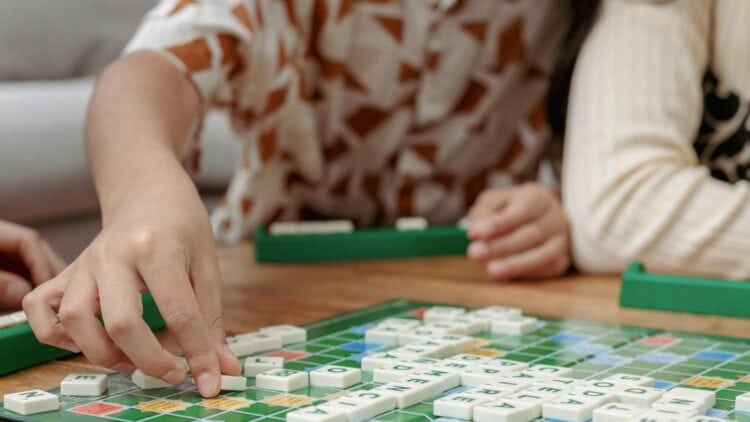
The game ends in one of three ways:
- When a player uses their last letter
- There are no more remaining plays
- A player passes two turns in a row
At the end of the game, players tally the remaining value of tiles they haven’t managed to play to be deducted from their final score.
So, if a player has a total of 100 points but has 3 tiles left on their rack with a combined point total of 7, their final score is 93 points (100-7=93).
If a player uses all their tiles during play, the sum of the unplayed letters of other players is added to their score. So, if there were 2 other players, and they each had 7 points left, the player with no tiles left gets an additional 14 points (7+7=14) to their final score.
The player with the highest score wins the game! In the event of a tie, the player with the highest score before unplayed letter modifications (addition or subtraction) wins.
HIGH SCORING SCRABBLE WORDS
Playing high-scoring words in Scrabble can help you make or break the game! A single high-scoring word can really turn the tide around when you’re losing and help you get far, FAR ahead of the other players when you’re already winning. Keep these high-scoring Scrabble words in mind in case you ever get a chance to play them!
- Quixotic – 28 points
- Quixotry – 27 points
- Quiz – 22 points
- Jiffy – 21 points
- Zippy – 21 points
- Qwerty – 21 points
- Quaky – 21 points
- Zinky – 21 points
- Hazy – 19 points
- Junky – 19 points
HIGH SCORING 2-LETTER SCRABBLE WORDS
Near the end of the game, you’ll undoubtedly end up having to play 2-letter words in order to avoid skipping your turn and missing out on some points. But don’t worry. You can score some pretty great points even with a 2-letter word:
- Qi – 11 points
- Za – 11 points
- Ax – 9 points
- Xu – 9 points
- Xi – 9 points
- Ex – 9 points
- Ox – 9 points
- Jo – 9 points
- By – 7 points
- My – 7 points
HIGHEST SCORING SCRABBLE WORDS EVER
But just knowing the high-scoring words is not enough. Thanks to the premium squares on Scrabble, just because a word is worth 15 points, doesn’t mean that’s all you get! Here are some of the highest-scoring Scrabble words ever played!
- Caziques – 392 points
- Quixotry – 365 points
- Defuzing – 332 points
- Freezing – 321 points
- Muzjiks – 128 points
Interestingly, theoretically, the highest-scoring Scrabble word is OXYPHENBUTAZONE, which can be worth a whopping 1,778 points when hooked to the right words! Entire worlds would need to align for you to be able to play this word, but you never know if this opportunity might present itself to you!
VARIATIONS OF SCRABBLE RULES
Here are some variations of Scrabble rules to play in case you’re ready to level up the game!
9 TILE SCRABBLE
The rules for this game are exactly the same as normal Scrabble, but you use nine tiles as opposed to seven. The one variation of rules is that you can achieve a fifty-point bingo with 7, 8, or 9 tiles, not just 9 tiles.
FINISH LINE SCRABBLE
Instead of playing until no plays or tiles remain, players play until one player reaches a specified score decided at the start of the game. This variation allows players to win more on skill level and creativity than in the original game!
| Beginner | Intermediate | Expert | |
| Two Players | 70 | 120 | 200 |
| Three Players | 60 | 100 | 180 |
| Four Players | 50 | 90 | 160 |
FAQ
Can You Put Words Next to Each Other in Scrabble?
Yes, absolutely! You can put words next to each other in Scrabble. In fact, this is one way to get even more points. However, the caveat is that every single word formed by your play must all be valid Scrabble words.
Can You Exchange Tiles in Scrabble?
If you absolutely cannot play any words or if you’d rather exchange your tiles, instead of playing a word, you may swap anywhere between one and seven tiles. You can only do this if there are at least seven tiles still in the bag, so this strategy wouldn’t work near the end of the game.
Can You Use the Double Word Space on Scrabble Twice?
According to official Scrabble rules, once a player has used any premium square, including Double Word, Triple Word, or Double Letter squares, no other player may reuse that square by connecting a new word to that square.
Can a Blank Tile Be Reused in Scrabble?
No, you cannot. You can’t replace a blank tile with the letter it represents in order to reuse it in a different word.
Can I Skip a Turn in Scrabble?
You can always skip your turn in Scrabble if you don’t want to make a word or exchange your tiles. In this case, you would get 0 points for this turn.
Can the Same Player Use the Same Word Twice in Scrabble?
There’s no rule against using the same word twice in Scrabble. In fact, you can spell the same word as many times as you want, as long as it fits!
- 40 Indoor Games for Adults: Board Games, Card Games, and Drinking Games - April 8, 2025
- 12 Best Trivia Board Games - March 24, 2025
- 45 Best Easter Games for Kids and Family - March 10, 2025
Hi. What happens when the 1st player uses all 7 tiles . Is the 50 points added after the double or do you double the entire score since its the 1st player?
Hi Raks, the 50 points are a bonus and are added in addition to the scoring of the word. They are scored independently of each other, so any bonuses that affect the scoring of the word specifically, are not applied to the additional 50 point bonus. I hope this helps.
The first player puts down joke going vertically down the board. The 2nd player adds an S onto joke and also makes the word star horizontally. So 2 words are created in the same turn. Joke becomes jokes and the word star is also played. Looks like this:
j
o
k
e
s t a r.
The S has landed on a triple word spot. How do you score this? I say both words are tripled. My friend says the actual face points are counted for both words, but because of the single use rule only one of the words gets the triple value, the other word gets counted at face value but not tripled My reading of the rules would give me 60 points, triple for both words. She says because of the single use rule you only get the triple on one of the words, so I’d score 48+4=52. Which of us is correct? Please explain the single use rule.
Hi Bonnie, both words would get triple scored because they were made at the same time with the triple score title, though any additional words made after would not get the triple bonus. I hope this helps.
L
e.
T.
T
e.
A r r e s t e d
player plays across bottom line using 7 letters. A and d land on triple word values. Is value multiplied by 9?
Hi Rick is when the word was created on the board both triple spaces were covered, yes the word would be multiplied by 9.
Hui , so I know that you can make two words when taking your turn, my question is , can you add more tiles to the second word to make a comlete word ?
Hello, You cannot make a word and add to a word in the same turn, but you may place your tiles for a new word, and then on your next turn add to it or a different word. I hope this helps.